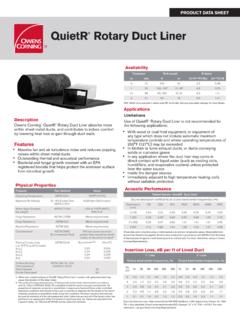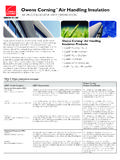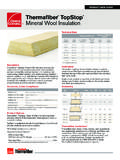Transcription of Better understanding needed for asphalt tank-explosion …
1 Better understanding needed forasphalt tank-explosion hazardsDavid G. TrumboreOwens- corning Fiberglas , R. WilkinsonOwens- corning Fiberglas , OhioBasic differences in the generation ofcombustible gas vapors in tanks stor-ing four classes of asphalt materialshave been identified by laboratory,pilot-scale, and plant-scale has been clearly shown that clas-sical methods of thinking about andtroubleshooting these hazards onlywork for flux and paving asphalts (andcan break down even for these materi-als), and are not applicable to solventdeasphalted residuum and latter have been shown, for thefirst time, to pose a special problemdue to their continued reactivity afterundergoing the air-blowing and temperature are criticalparameters in determining and con-trolling the degree of this measurement techniqueswere developed to monitor all thesehazards, and these techniques areconsidered to be necessary to moreaccurately determine the vapor spacehazard in all asphalt In spite of the exten-sive use of hot asphalt for over acentury.
2 Little has been published onthe nature of explosion hazards in itsstorage tanks . Most of what has beenpublished has emphasized that theflash point of the material stored is themost important factor in determiningif enough fuel is present in the vaporspace for combustion. Dimpfl4 concluded that factors un-related to simple evaporation of as-phalt are common causes of the build-up of combustibles in asphalt cited smoldering coke deposits onthe inner roof and shell of the tank,incidental thermal cracking, light hy-drocarbons from solvent deasphalting(SDA) processes, contamination fromcrude feed/vacuum residuum heat ex-changer leaks, and unstripped lighthydrocarbons generated during airblowing as being potential sources ofvapor space fuel not detected by flashpoint emphasized smoldering coke srole in depleting oxygen and elevatingcarbon monoxide and carbon dioxidein the tank vapor space, and pointedout its potential as an ignition source,with or without the catalyzing effect ofiron sulfide.
3 However, based on hissampling of nine tank vapor spaces,Dimpfl was not able to predict whatmaterial and storage conditions tend-ed to give explosive vapor spaces. Hisfinal conclusion was that the storageof asphalt is an unpredictable work described in this articlewas undertaken to build an under-standing of the factors affecting theaccumulation of combustible vaporsin tanks storing various types of as-phalt. The key to this effort has beenan extensive tank vapor space-moni-toring program in which we havedeveloped simple methods of evaluat-ing asphalt tank vapor-space methods are currently beingused in our manufacturing facilities todefine specific tank hazards, thus pro-viding us with an ever-expanding database to aid in predicting and control-ling high-risk situations.
4 This in-planttesting is being complemented by labevaluations of materials, developmentof new testing methods, and more-sophisticated characterization of actu-al vapor verification of the accuracy of thesimpler tank-monitoring methods hasbeen completed, and that work isbeing prepared for compositions. Todate, our measurements of nearly2,000 individual vapor spaces in over200 tanks has led to the view ofasphalt tank vapor-space composi-tions summarized in Figs. 1, 2, and three figures present data onfour classes of hot asphalt tanks -those storing roofer s flux (vacuumtower bottoms generally of low vis-cosity and high flash point that can beprocessed into high softening pointgrades of roofing asphalt by air blow-ing), paving asphalt , SDA, and air-blown asphalts.
5 Included are exam-ples of vapor-space the case of the flux and pavingasphalt tanks , the values presentedrepresent overwhelmingly typical val-ues. The SDA and air-blown asphalttank values reflected hazardous ex- asphalt tank Paving SDA Air blownIIFlux Paving SDA Air blownFig. 2 Combustibles in asphalt tanks 98C2+ HCReprinted from the September 18, 1989 edition of Oil & Gas JournalCopyright 1989 by PennWell Publishing CompanyFig. 3 Hydrocarbons in tank vapor spaceC1C3C5C7C9C11Cl3C15B SDAx Air blowno FluxC PavingOGJI tremes that, while far from typical,were encountered often enough to beof general the other extreme, the vaporspaces in tanks storing these two ma-terials look very much like the vaporspaces in the flux and paving vapor space of an SDA tank wasgenerally at one of these two ex-tremes, while in air blown asphalttanks both extremes and all points inbetween are 1 divides the example tankvapor space compositions into fourcomponents.
6 Combustibles, carbondioxide, water vapor, and oxygen,and presents them in a stacked barchart. The difference between the to-tal bar height and 100% is nitrogenfrom air. Note that none of the tanksdiscussed in this study were the data, it is clear that typicalflux and paving tanks have little morethan nitrogen, oxygen, a little watervapor,and a very small amount ofcombustibles in their vapor spaces,the SDA residuum tanks had, in theextreme case, a large combustible gasfraction, and again in the extremecase, the air-blown asphalt tanks hada large combustible gas fraction aswell as large water vapor and carbondioxide 2 divides the important com-bustible gas fraction into four addi-tional levels.
7 Methane, other hydro-carbons, carbon monoxide, and hy-drogen sulfide. The data on our exam-ples, once again, indicate nothinghazardous in the typical flux and pav-ing tanks and only the other hydro-carbon fraction in the SDA extreme air-blown asphalttanks, on the other hand, had largemethane and carbon monoxide com-bustible fractions in addition to a large other hydrocarbon fraction, andwas the only tanksignificant amountAir-blown asphalt *Fig. 4L4*Causesmore combustibles evolutionl380 400 420 440 460 480 Storage temperature, to have a create a tank vapor space problemof hydrogen sulfide because of solvent contaminationin the vapor , Fig.
8 3 breaks the otherhydrocarbon fraction of Fig. 2 into aprofile of carbon number data indicate that the flux, pav-ing, and air-blown asphalt tanks had abroad spectrum of hydrocarbons pre-sent in their vapor spaces, whereasthe SDA tank had a single spike at thecarbon number that in every case ofhigh combustible gas readings in ourexperience corresponded to the sol-vent used in producing this data summarized in the aboveexamples give a view of hot asphalttanks as and paving tanks thus tend tofollow the traditional view of asphalttank safety as being well-defined byflash point measurements.
9 Contami-nation problems with these materialsare not unknown but not gas buildup in fluxand paving tanks can typically becharacterized by their flash these materials are generallystored at temperatures substantiallybelow their COC flash point, the va-por spaces are typically low in com-bustible gas contamination does occur,the control of hazards by flash pointcan break down, depending on thecontaminant and the flash point meth-od generally used. We have moni-tored over 100 tanks storing thesematerials and have only seen elevatedcombustible gas levels with fluxstored at high temperatures where theflux was inadvertently aerated, andwith paving that was made fromblending solvent contaminated deasphalted residuum canfrom the deasphalting process if thesteam stripping of the material is notadequate.
10 This problem appears to bea strong function of the supplier sprocess, the solvent used, and theamount of ventilation in the tankwhere the material is of the high volatility of thesolvents in question (propane throughpentane), these hazards are not de-tected by flash-point , from the data in Figs. 1 and2, it is obvious that air-blown asphaltis an entirely different material from atank-hazard standpoint, and it de-serves some more extensive discus-sion. The basic uniqueness of thismaterial from a loss-prevention stand-point has not, to our knowledge, beenrecognized asphalts. An experimentdone in Trumbull s pilot plant conver-tor illustrates the basic difference inthe air-blown asphalt hazard.
















